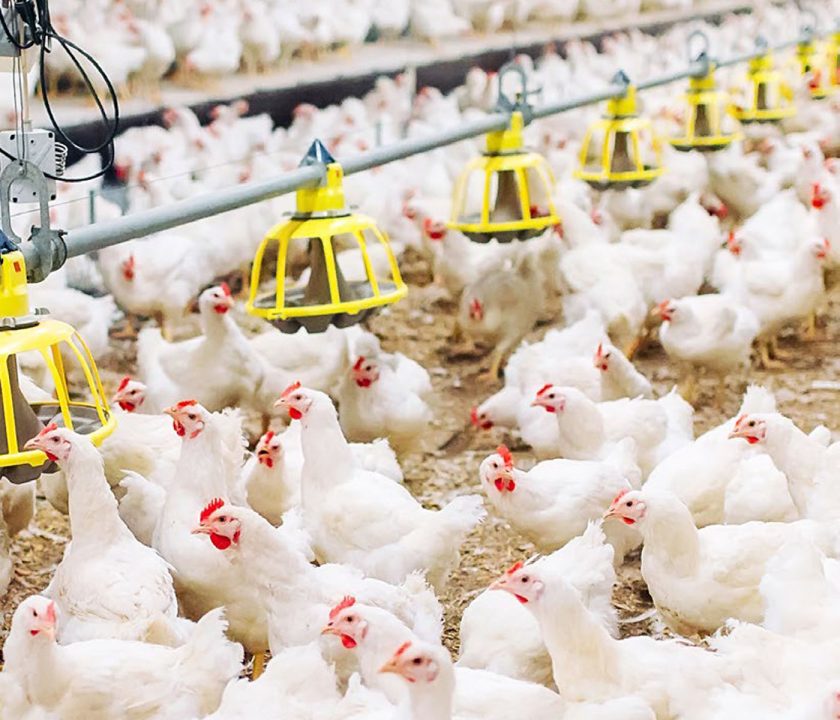Content available at: Indonesia (Indonesian) ไทย (Thai) Tiếng Việt (Vietnamese) Philipino
Mostly breeder managers utilize manual fleshing scores to know the body conditions in broiler breeders; however, this assessment is variable due to depending on the manager’s subjective score and labor turnover. To cope with this, Credinser has developed a device for measuring the breast meat angle, named Flesher, Figure 1.
This tool has the following benefits:
PRECISION
- The Flesher contains continual numbers expressed as degrees; without using the subjective manual flesher score.
- These continuing degrees offer reliable information producing precise analysis of breast meat growth.
PRACTICAL
Identifying the correct place in the breast meat and applying sufficient force between the Flesher and the bird makes it practical and easy to use.
FLESHER ANGLE CONVERSION
Managers can convert the angles of the Flesher to a standard Flesher score; using a simple linear equation.
RECORDS DURING CRITICAL PERIODS AND FIELD TESTS
- Managers can use this tool from four until 65 weeks of age. Although, in times of limited labor, they can record the Flesher angles weekly from 18 to 28 weeks of age for females and from 18 to 33 weeks for males.
- For field tests, the managers could record the Flesher angles every week or at least every other week using the same weighted birds, resulting in great company benefits.
SUPPORT BODY WEIGHTS
- Provides reinforcement when the body weights are inconsistent. For example, sometimes live weights are higher or lower than expected.
- To deal with this problem, recording Flesher measurements and live weight values will allow confidence and trust in the outcomes, preventing extra time and labor used.
AVOID DIGESTA VARIATIONS IN LIVE WEIGHTS
External factors such as weighing time, environment, type of diet, or even health status will influence the final body weight showing fluctuations due to the amount of digesta.
- This digesta, composed of feed and water in the intestinal tract, will produce a variation in the live weights.
- The Flesher values will account for the development of breast meat per se without considering the diverse digesta.
HELPS TO DESIGN NEW BODYWEIGHT PROFILES
In the continuous development of broiler genetics, new live weight profiles should be tested constantly to produce the highest live performance and economic return.
- The Flesher evaluation will help to adjust some body weights with inconsistent values.
- To achieve this, managers can use simple correlations between Flesher and live weight to adjust some weights and develop new bodyweight profiles.
IDENTIFY THE BODY COMPOSITION DUE TO DIETARY ENERGY-TO-PROTEIN RATIOS
In pullet breeders finding the best body composition due to energy-to-protein ratios will yield the highest chick output per hen house. These dynamic body depositions could be recorded indirectly by registering the abdominal fat or breast meat.
- The breast meat angle of the Flesher can easily be related to the whole breast muscle weights, producing simple linear equations.
- In commercial trials, the fluctuation of body composition due to dietary nutrients requires a calculation of muscle growth during the whole period for the same group of birds.
For this reason, managers can apply this tool for field breeder trials testing new dietary nutrients during the rearing or production phases.
INDIRECT MEASURE OF ABDOMINAL FAT
- When managers compare birds with similar body weights, birds with more breast muscle meat contain less abdominal fat.
- Thus, quantifying the breast muscle will also provide information on the fat gain.
- Therefore, the dimensions of the Flesher will provide insight into body fat growth.
CERTAINTY IN THE FEED ALLOCATIONS
- When the body weights and Flesher evaluations have a similar trend, calculating the new feed intake for next week will provide confidence.
- When there are discrepancies between Flesher degrees and body weights, the Flesher degrees will guide to supply the final amount of feed.
ENHANCE BODY WEIGHT UNIFORMITY
- By providing the proper feed allocations for the different categories or groups of birds, the birds reduce the body weight variation every time they eat the amount of feed calculated with certainty with the help of this instrument.
- The angular values and coefficient of variation of the angles from each category will give more insights for supplying precise feed amounts.
- Herein, in general, the variation of the Flesher angles is more sensitive than the variation of the live weight; for this reason, the coefficient of variations of the Flesher is higher than that of the live weight for females or males.
INCREASE AND EXPLAIN EGG PRODUCTION
To accomplish persistence and high egg production, adequate body composition and bodyweight uniformity require information on body weight profile and body tissue gains during the pullet period.
- The Flesher evaluation in pullets will help to sustain better body weight uniformity and find the best muscle growth.
- Further, when new dietary amino acids and insoluble fiber levels are, for instance, tested, birds lay eggs according to their muscle growth and body fat reserves.
- In this way, the Flesher values will explain the results due to new dietary changes.
IMPROVE FERTILITY AND HATCHABILITY
- Accurate estimation of the breast meat in roosters will allow for controlling the male growth averting overweighs as roosters age.
- Selecting and producing taller roosters by precise feed amounts, bodyweight profile, and Flesher values during the rearing period will establish a high amount of roosters with homogenous breast meat and successfully mating.
- This approach will avoid the scenario of short roosters with huge over-fleshing that are prone to incomplete mating.
- Further, during the lay period, with a controlled rooster live-weight gain and thereby fleshing growth due to using this tool, the fertility will keep high as the hen ages.
CONCLUSIONS
- The Flesher angles open an opportunity for supporting body weight, feed intake, breast meat uniformity, and body composition.
- Proactive poultry companies would benefit by evaluating field tests using Flesher appraisals, leading to high egg production, fertility, and hatchability persistence.

